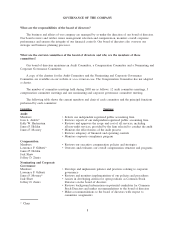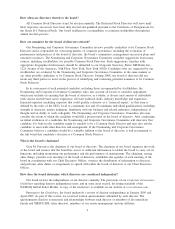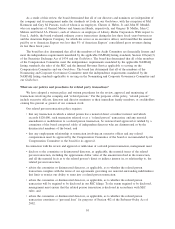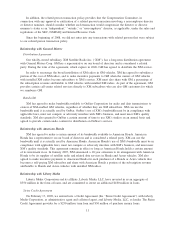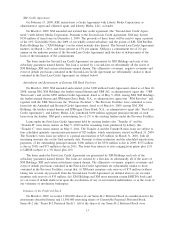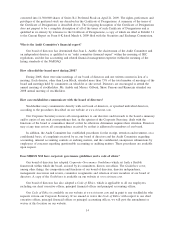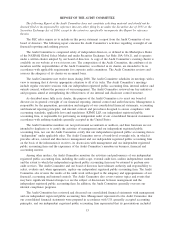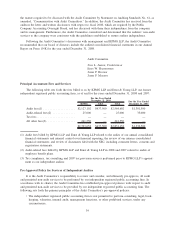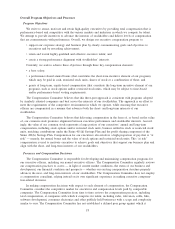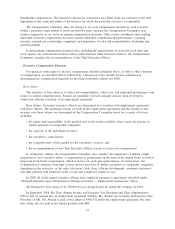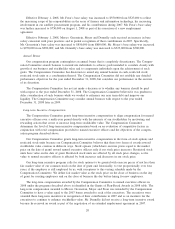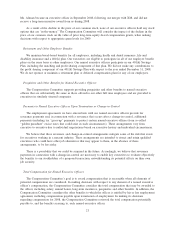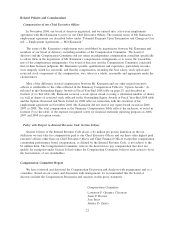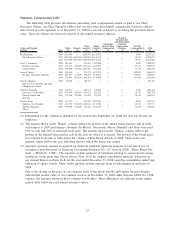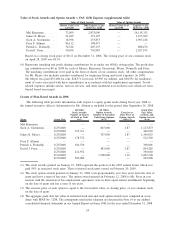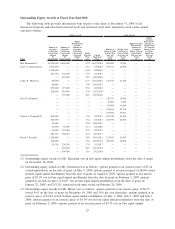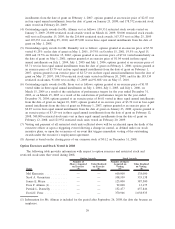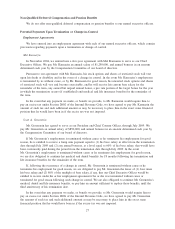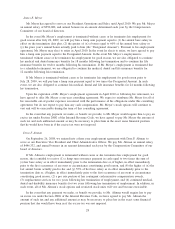XM Radio 2008 Annual Report Download - page 130
Download and view the complete annual report
Please find page 130 of the 2008 XM Radio annual report below. You can navigate through the pages in the report by either clicking on the pages listed below, or by using the keyword search tool below to find specific information within the annual report.Overall Program Objectives and Processes
Program Objectives
We strive to attract, motivate and retain high-quality executives by providing total compensation that is
performance-based and competitive with the various markets and industries in which we compete for talent.
We attempt to provide incentives to advance the interests of stockholders and deliver levels of compensation
that are commensurate with performance. Overall, we design our executive compensation program to:
• support our corporate strategy and business plan by clearly communicating goals and objectives to
executives and by rewarding achievement;
• retain and recruit highly qualified and effective executive talent; and
• create a strong performance alignment with stockholders’ interests.
Currently, we seek to achieve these objectives through three key compensation elements:
• a base salary;
• a performance-based annual bonus (that constitutes the short-term incentive element of our program),
which may be paid in cash, restricted stock units, shares of stock or a combination of these; and
• grants of long-term, equity-based compensation (that constitute the long-term incentive element of our
program), such as stock options and/or restricted stock units, which may be subject to time-based
and/or performance-based vesting requirements.
The Compensation Committee believes that this three-part approach is consistent with programs adopted
by similarly situated companies and best serves the interests of our stockholders. The approach is an effort to
meet the requirements of the competitive environment in which we operate, while ensuring that executive
officers are compensated in a manner that advances both the short- and long-term interests of our
stockholders.
The Compensation Committee believes that delivering compensation in the form of, or based on the value
of, our common stock promotes alignment between executive performance and stockholder interests. Accord-
ingly, the value of our common stock represents a large portion of our executives’ annual and long-term
compensation, including stock options and/or restricted stock units, bonuses settled in stock or restricted stock
units, matching contributions under the Sirius 401(k) Savings Plan and the profit sharing component of the
Sirius 401(k) Savings Plan. Compensation for our executives also involves a high proportion of pay that is “at
risk” — namely, the annual bonus and the value of stock options and restricted stock units. This “at risk”
compensation is used to motivate executives to achieve goals and objectives that support our business plan and
align with the short- and long-term interests of our stockholders.
Processes and Compensation Decisions
The Compensation Committee is responsible for developing and maintaining compensation programs for
our executive officers, including our named executive officers. The Compensation Committee regularly reviews
our compensation practices to assess — in light of current market conditions, the status of our business and
development, our financial condition and prospects — whether our existing compensation structure properly
advances the near- and long-term interests of our stockholders. The Compensation Committee does not employ
a compensation consultant, relying instead on its own significant experience in making executive compensa-
tion-related decisions.
In making compensation decisions with respect to each element of compensation, the Compensation
Committee considers the competitive market for executives and compensation levels paid by comparable
companies. The Compensation Committee from time to time reviews the compensation practices, including
total compensation, at companies with which it competes for talent, including radio, television, cable, film,
software development, consumer electronics and other publicly held businesses with a scope and complexity
similar to ours. The Compensation Committee has not established a defined peer group against which it
18


